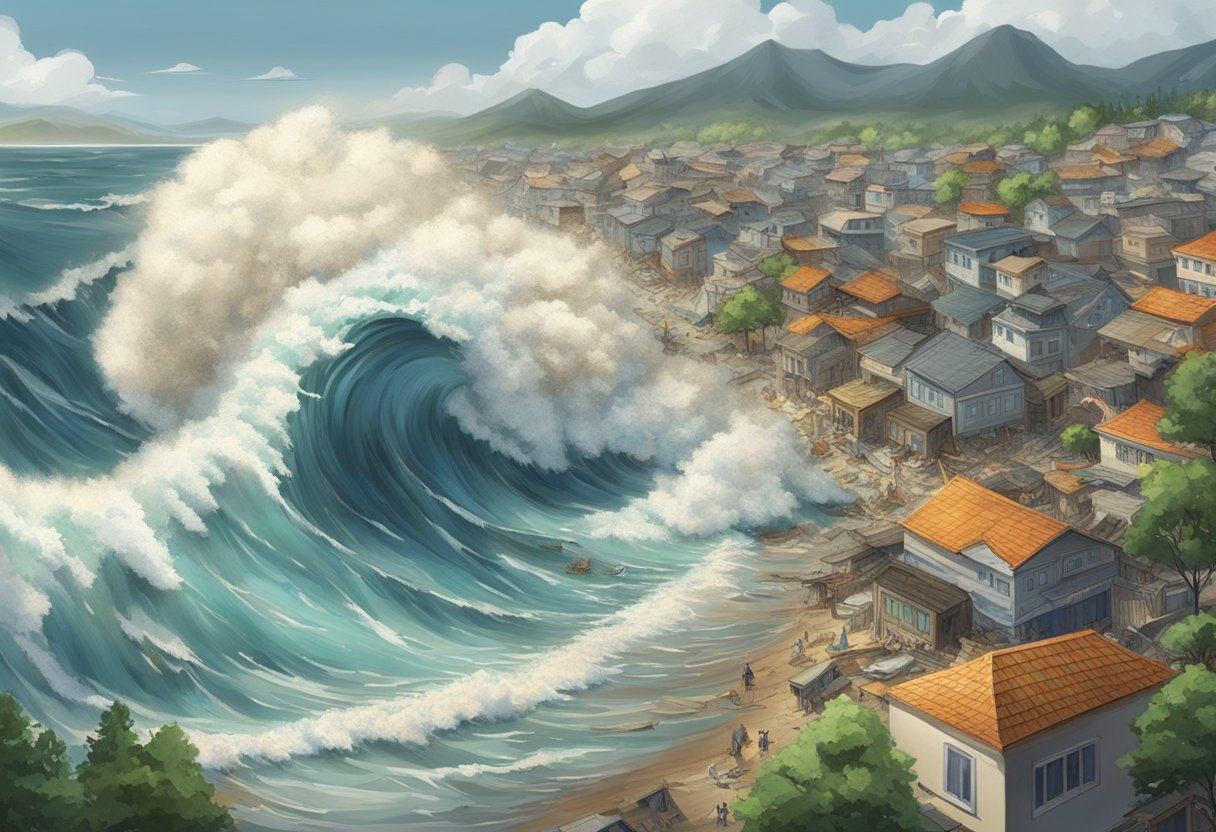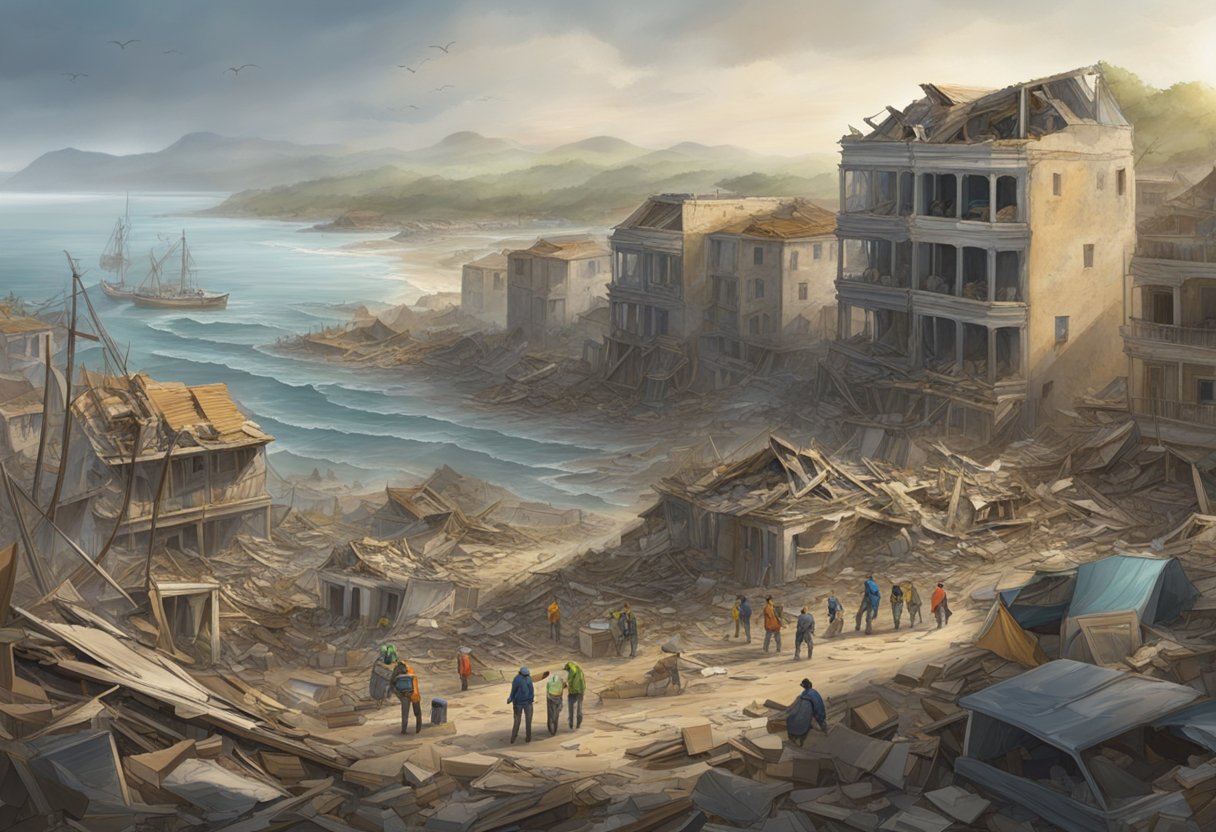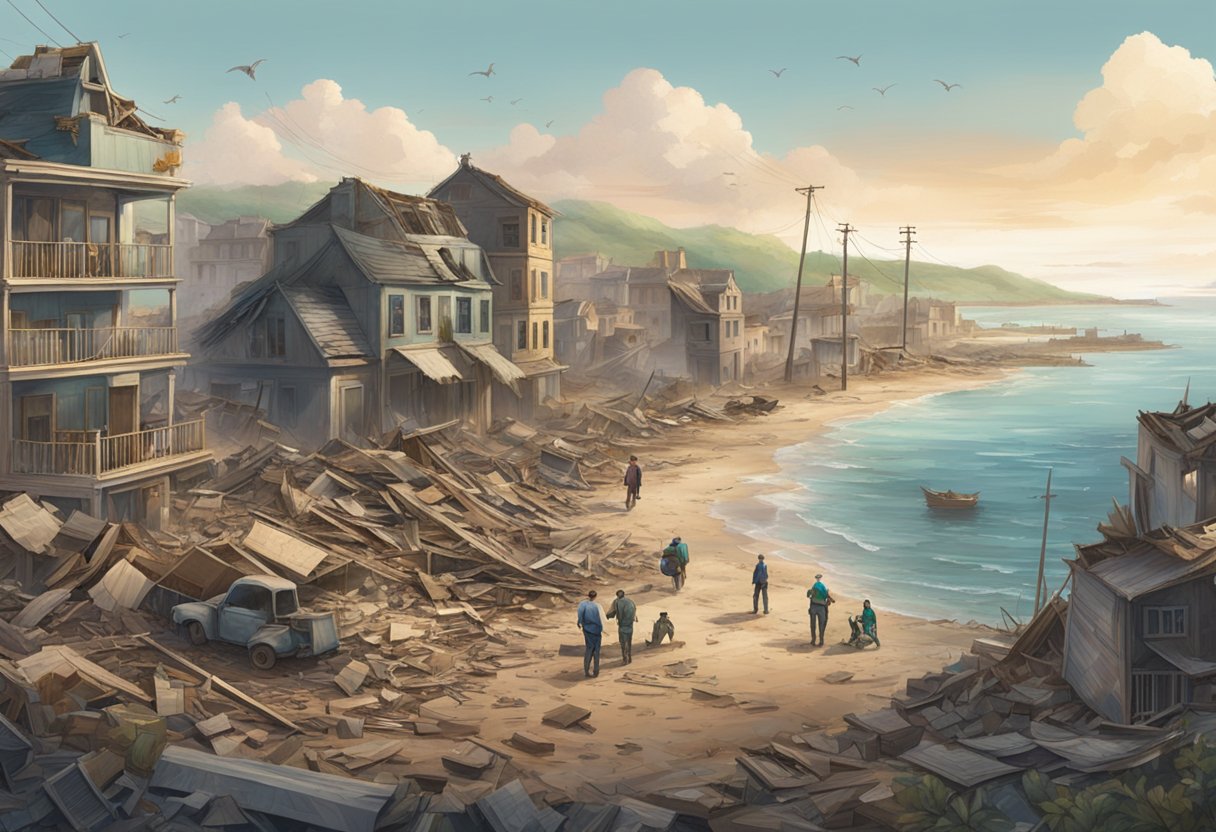The 2004 Indian Ocean Tsunami Disaster: Analyzing Global Response and Recovery Efforts

On December 26, 2004, the Indian Ocean faced one of the deadliest natural disasters in recorded history. A massive tsunami, triggered by an underwater earthquake, devastated the coastal areas of countries like Thailand, Indonesia, and Sri Lanka. The disaster led to the loss of over 227,000 lives and displaced more than 1.7 million people across 14 countries.
The response to the catastrophe was global and immediate. An international team of experts, including geographers, geologists, anthropologists, and political scientists, rushed to the hardest-hit areas. Their efforts, combined with substantial domestic and international aid, played a crucial role in the initial recovery and rebuilding process. This worldwide coordination demonstrated the power of collective action in the face of overwhelming adversity.
A decade after the disaster, regions like Aceh in Indonesia showed remarkable resilience and recovery. The combined efforts of individual ingenuity, community engagement, and significant support from both local and international entities helped rebuild these areas. The story of Aceh stands as a testament to human strength and the positive impact of global cooperation in disaster recovery.
The Onset of the 2004 Indian Ocean Tsunami
On December 26, 2004, a massive undersea earthquake off the coast of Sumatra triggered one of the most devastating tsunamis in history. This disaster led to widespread destruction and loss of life across several countries.
Earthquake and Tsunami Formation
The earthquake struck at approximately 7:59 am local time, originating off the coast of the Indonesian island of Sumatra. It had an estimated magnitude of 9.1, making it one of the strongest earthquakes ever recorded. The intense seismic activity caused the seafloor to uplift, displacing massive amounts of water and generating powerful waves.
These waves traveled across the Indian Ocean at speeds of up to 500 miles per hour. Within minutes, coastal regions were inundated by the tsunami's forceful surge. The energy released was equivalent to about 23,000 Hiroshima-type atomic bombs, creating waves as high as 100 feet in some places.
Affected Regions
The tsunami impacted numerous countries along the Indian Ocean Rim, with the hardest-hit areas being Indonesia, India, Sri Lanka, and Thailand. In Indonesia, particularly in the province of Aceh, entire villages were wiped out.
Sri Lanka experienced extensive coastal flooding, causing thousands of deaths in cities like Galle and Colombo. In India, the states of Tamil Nadu and Andhra Pradesh saw significant destruction. Thailand’s popular tourist destinations, including Phuket and Khao Lak, also faced heavy losses both in lives and infrastructure.
Initial Response
The immediate response involved local communities and governments scrambling to address the unfolding tragedy. Emergency services, often overwhelmed by the scale of the disaster, began rescue operations amidst widespread chaos and communication breakdowns.
International aid poured in rapidly. Various countries, as well as non-governmental organizations (NGOs), mobilized resources including food, water, medical supplies, and personnel. The global community contributed billions of dollars in aid, aiming to support rescue efforts and provide temporary shelter to millions displaced by the disaster.
Efforts were also made to recover and identify bodies, manage public health issues, and start the long process of rebuilding affected areas. Despite the challenges, these coordinated efforts helped to stabilize the region in the aftermath of the catastrophic event.
Impact Analysis

The 2004 Indian Ocean Tsunami had significant impact, affecting human life, economies, and the environment. Researchers studied the most damaged areas to document this tragedy.
Human and Economic Loss
The tsunami resulted in a staggering number of deaths and injuries. Approximately 230,000 people across 14 countries died, with Indonesia, Sri Lanka, India, and Thailand being the hardest hit. The direct economic losses totaled billions of dollars. Entire communities were destroyed, with homes, businesses, and infrastructure obliterated.
Survivors faced long-term economic challenges. Fishing and farming sectors, crucial for local economies, were severely disrupted. Many were left without livelihoods. Immediate international aid played a critical role in relief, but rebuilding efforts spanned many years.
Environmental Consequences
The tsunami also devastated the natural environment. Coastal ecosystems such as mangroves, coral reefs, and wetlands suffered severe damage. Saltwater intrusion rendered agricultural land barren, compounding food security issues.
Debris and pollutants from destroyed structures contaminated water bodies. In some areas, the force of the water eroded beaches and reshaped coastal landscapes. Efforts to restore these environments involved replanting mangroves and coral restoration projects to begin ecological recovery.
Study of Affected Areas
Following the tsunami, teams of experts, including geographers, geologists, and anthropologists, were dispatched to study the regions most impacted. These studies provided vital data on the disaster’s effects and informed future disaster preparedness strategies.
Geographers mapped changes in land use and population displacement. Geologists examined the tectonic activity that triggered the tsunami. Anthropologists studied cultural impacts and community resilience. These multidisciplinary efforts created a comprehensive understanding of the disaster's impact and helped improve responses to future natural disasters.
Global Humanitarian Actions

The 2004 Indian Ocean Tsunami triggered a vast and unprecedented global humanitarian response. Countries, international organizations, and NGOs mobilized quickly to provide aid and relief to the affected regions.
International Aid Mobilization
International aid was swift and overwhelming. Over 13.5 billion dollars in donations flowed in from governments, private individuals, and organizations. This massive influx of funds aided in addressing both immediate needs and long-term recovery efforts.
Countries such as the United States, Australia, Japan, and many European nations provided significant financial assistance. Military units from different countries deployed to help with rescue and relief operations. Food, water, medical supplies, and temporary shelter were quickly distributed to support survivors.
Table: Aid Contributions by Major Donors
| Country | Contribution ($ Billion) |
|---|---|
| United States | 2.8 |
| Australia | 1.3 |
| Japan | 0.5 |
| EU | 2.1 |
Roles of the United Nations and NGOs
The United Nations (UN) played a pivotal role in coordinating the global response. Agencies like UNICEF, the World Health Organization (WHO), and the World Food Programme (WFP) provided essential services. They organized vaccination campaigns, nutritional support, and sanitation facilities to prevent disease outbreaks.
Non-Governmental Organizations (NGOs) like the Red Cross, Oxfam, and Save the Children delivered immediate relief and facilitated rebuilding efforts. Local NGOs also participated, ensuring that aid reached remote and severely affected areas. These organizations helped in constructing homes, schools, and healthcare facilities.
Key UN Agencies and NGOs Involved:
- UNICEF: Child protection and education
- WHO: Public health initiatives
- WFP: Food distribution
- Red Cross: Emergency response and medical aid
- Oxfam: Water and sanitation projects
Collaboration for Relief Operations
Collaboration was essential for effective relief operations. International agencies, governments, and NGOs worked together to streamline efforts and avoid duplication. Joint task forces were established to manage logistics, distribution, and resource allocation.
Example of Collaborative Efforts:
- Joint Operations Centers: Facilitated information sharing
- Combined Military Missions: Provided rapid and coordinated responses
- Shared Resources: Pooled supplies and expertise for efficient aid delivery
This unified approach increased the impact and reach of humanitarian efforts, ensuring that help was timely and effective.
Reconstruction and Recovery Efforts

After the 2004 Indian Ocean tsunami, affected regions undertook extensive efforts to rebuild infrastructure, restore economic stability, and enhance healthcare and education services. These initiatives aimed at long-term resilience and community strengthening.
Restoring Infrastructure and Housing
Communities severely impacted by the tsunami required rebuilding of homes, roads, bridges, and public facilities. Over 40 key aid agencies—including the United Nations and various NGOs—joined to form the Tsunami Evaluation Coalition. This coalition coordinated efforts to reconstruct damaged infrastructure efficiently.
Housing reconstruction was a priority. Countries like Indonesia and Sri Lanka invested millions in rebuilding homes, ensuring they were more resilient to future disasters. Urban areas received enhanced road networks and transportation systems. Coastal areas also saw the construction of new protective barriers to mitigate future risks.
Economic and Social Rehabilitation
Rehabilitation extended beyond physical reconstruction. Economic recovery included revitalizing local industries such as fishing and tourism, which were critical for the livelihoods of affected communities. Microfinance programs and job creation initiatives provided individuals with the means to rebuild their lives.
Social support systems were established to help communities heal and re-integrate. Programs focusing on mental health support and community engagement fostered social cohesion. International aid played a crucial role, with billions of dollars in grants flowing into the region to support these initiatives.
Healthcare and Educational Initiatives
Healthcare improvements targeted both immediate needs and long-term sustainability. Hospitals and clinics that were destroyed were rebuilt, often with better facilities. Medical services were expanded to be more inclusive and resilient to future disasters. Vaccination drives and public health campaigns were initiated to address immediate healthcare crises.
Educational efforts ensured that children continued their schooling despite the disaster. New schools were constructed, and existing ones were repaired. Educational programs were developed to teach children about disaster preparedness, incorporating local context and experiences. Scholarships and educational materials were provided to support ongoing learning and development in the region.
Psychosocial Response to Trauma

The effects of the 2004 Indian Ocean Tsunami included widespread emotional trauma. Many efforts focused on addressing post-traumatic stress and fostering community resilience.
Addressing Post-Traumatic Stress
The tsunami caused significant emotional distress. Many survivors experienced post-traumatic stress. Various organizations, including UNICEF, provided psychological support to affected communities.
Efforts involved counseling services and mental health camps. The Schizophrenia Research Foundation (SCARF) was active in offering psychosocial support. Their services aimed to alleviate psychological symptoms like anxiety and depression.
In coastal Tamil Nadu, studies showed high prevalence rates of psychiatric disorders. Around 27.2% of adults suffered from these issues six to nine months after the crisis. Addressing these disorders was critical for recovery.
Community Resilience Building
Building community resilience was key after the tsunami. Efforts included strengthening social cohesion and rebuilding support networks. Community-based programs helped in this regard.
Social support groups played an important role. An example is the "Social Support and Counseling" group that organized activities to promote healing and resilience.
Workshops and training sessions were conducted. These aimed at empowering communities with the skills to handle future trauma. Rebuilding community infrastructure also contributed to a sense of normalcy and safety.
Communities demonstrated notable resilience in the face of adversity. Through these combined efforts, the affected populations were better equipped to recover and rebuild their lives.
Long-Term Development Strategy
Successful long-term recovery from the 2004 Indian Ocean tsunami required a multifaceted approach, integrating sustainable development goals and international cooperation. The aim was not just to rebuild, but to ensure communities could thrive.
Sustainable Development Goals Integration
The United Nations played a key role in integrating Sustainable Development Goals (SDGs) into the recovery plan. The focus areas included:
- Quality Education: Rebuilding and improving schools ensured children could continue their education.
- Good Health and Well-being: Establishing clinics and hospitals was essential for both immediate medical needs and long-term community health.
- Clean Water and Sanitation: Projects aimed at providing access to clean water and proper sanitation helped reduce disease and improved quality of life.
- Affordable and Clean Energy: Initiatives promoting renewable energy sources helped communities become more self-sufficient and resilient.
International Collaborative Projects
International cooperation was crucial in the recovery efforts. Key players included:
- World Bank: Provided significant funding and expertise aimed at rebuilding infrastructure such as roads, bridges, and schools.
- NGOs and Private Sector: Organizations like Oxfam and various private companies contributed to housing projects, livelihood programs, and technology support.
- Bilaterals: Several countries offered direct aid, sharing expertise, and sending volunteers to assist on the ground.
- Community Engagement: Local communities were encouraged to participate in planning and executing recovery projects, ensuring the initiatives met the actual needs and leveraged local knowledge and skills.
Combining resources and expertise from these different entities helped ensure a thorough and sustainable recovery effort.
Analyzing Progress and Lessons Learned
Significant strides have been made in disaster response and preparedness since the 2004 Indian Ocean Tsunami. The insights gained have shaped global policies and improved strategies for handling such catastrophic events.
Review of the Global Response
Immediately after the tsunami, the international community sprang into action. Nations around the world, along with international organizations, provided humanitarian aid. They sent medical teams, food, water, and financial support. Non-governmental organizations (NGOs) played a crucial role in immediate relief operations.
The efforts were not limited to immediate relief. Countries collaborated to rebuild infrastructure, homes, and communities. The United Nations led many reconstruction projects, ensuring that aid reached the most affected areas. The coordinated global response showcased the strength of international solidarity.
Improvements in Disaster Preparedness
One of the most vital lessons learned from the 2004 disaster was the need for better disaster preparedness. Countries bordering the Indian Ocean significantly upgraded their early warning systems.
Tsunami Warning Centers were established, equipped with advanced technology to detect undersea earthquakes. Communities were educated on evacuation procedures and safety protocols. Regular drills were conducted to ensure readiness.
There was also a focus on building resilience in communities. Infrastructure was designed to withstand future tsunamis, and probabilistic tsunami hazard maps were used for safer land-use planning. These measures have increased overall safety and reduced vulnerability to future events.
Post-Tsunami Studies and Insights
Research following the tsunami has provided deep insights into disaster impact and recovery. The Study of the Tsunami Aftermath and Recovery (STAR) project has been instrumental in this regard. It examined the socio-economic effects on the affected populations over time.
Studies identified long-term psychological impacts on survivors, emphasizing the need for mental health support in disaster response plans. Recovery efforts showed that incorporating local communities in decision-making led to more effective rebuilding.
The United Nations Office for Disaster Risk Reduction (UNDRR) has documented key findings and shared them globally. These insights have driven improvements in disaster management practices, providing a blueprint for handling future calamities effectively.
Reflections on Humanitarian Efforts
The 2004 Indian Ocean tsunami marked a significant moment for humanitarian response around the globe. It shaped new practices and highlighted the value of coordinated aid.
Evaluating the Role of Humanitarian Assistance
Humanitarian assistance was crucial in the aftermath of the 2004 tsunami. Donations poured in, with around $13.5 billion contributed by the global community, nearly 40 percent of which came from private individuals. These funds helped provide immediate relief, including food, water, and medical supplies to survivors.
Aid organizations set up temporary shelters and facilitated the rebuilding process. Not only did this help restore infrastructure, but it also offered emotional and psychological support to those affected. Coordination among multiple agencies ensured that resources were used efficiently, minimizing duplication of efforts and maximizing the impact.
Professionals in the field learned important lessons about the value of joint efforts and communication. This disaster underscored the necessity of being prepared and the importance of having robust systems in place.
Engaging with the Humanitarian Community
The disaster became a catalyst for stronger cooperation within the humanitarian community. Different countries and organizations came together, sharing resources and expertise. Groups like Oxfam and UNICEF played significant roles in directing efforts on the ground.
Professionals from varied backgrounds, including geographers, geologists, and anthropologists, collaborated to better understand the disaster’s impact. This multi-disciplinary approach allowed for more comprehensive recovery plans. The engagement with local communities also improved, ensuring that the assistance provided matched the needs of those affected.
The experience from the 2004 tsunami response strengthened global practices and protocols. The humanitarian community emerged better equipped to handle future disasters, leading to improved responses in subsequent crises.
The Role of Education in Disaster Management
Education plays a critical role in disaster management. It helps communities understand risks and prepare for emergencies. Through disaster education, people learn how to respond quickly and effectively during crises.
Schools are key sites for spreading awareness. They incorporate disaster-preparedness topics into their curriculum. This helps students learn emergency protocols, evacuation routes, and safety measures.
Community workshops are another effective tool. These sessions teach residents about local hazards and emergency response plans. Participants gain valuable skills, such as first aid and search-and-rescue techniques.
Training for teachers and administrators is essential. Well-prepared educators can guide students and staff during emergencies. They learn how to conduct drills, use emergency equipment, and communicate effectively in crises.
Collaboration with local authorities enhances the impact of educational programs. Partnerships with fire departments, police, and medical services provide hands-on training and resources. This cooperation ensures that the community is well-prepared and resilient.
Regular drills and exercises reinforce learning. Schools and community centers conduct these drills to practice responses. They help identify weaknesses in preparedness plans and improve overall readiness.
Educational materials like manuals, videos, and online resources support learning. These materials are tailored to different age groups and literacy levels, making information accessible to all.
Promoting a culture of safety through education leads to long-term benefits. Informed citizens make better decisions, reducing the impact of disasters. They are more likely to invest in safety measures and participate in community preparedness activities.




